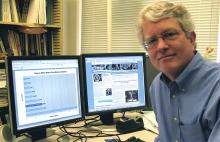
With 16 executive orders and 11 memoranda issued to the executive branch in his first 30 days in office, President Barack Obama leads all of his predecessors in volumes of unilateral action. However, among presidents who took office following administrations of the opposite party, he is the only one not to have given any formal messages to Congress in the first four weeks after inauguration. His first address to Congress took place yesterday, his 36th day in office.
These facts –– and many others –– are being tracked through a new feature on the American Presidency Project, a Web site developed by a pair of political scientists at UC Santa Barbara. Containing well over 85,000 written documents and more than 700 recordings, the site has become the definitive online source for presidential documents. It was developed by John Woolley, professor and chair of political science, and Gerhard Peters, a political science graduate student who now teaches at Citrus College.
With the new feature, Woolley and Peters compare Obama's activity level with that of other commanders in chief who took office following a president from the opposite party. The study begins with Franklin Delano Roosevelt in 1933, and includes Dwight D. Eisenhower (1953), John F. Kennedy (1961), Richard M. Nixon (1969), Jimmy Carter (1977), Ronald Reagan (1981), Bill Clinton (1993), and George W. Bush (2001).
"We decided to produce a series of reports we'll update periodically, analyzing the activity level of the Obama White House in relation to that of other administrations," said Woolley.
"We're analyzing partisan change because those presidents have the greatest incentive to take unilateral action and change the policy agenda."
In addition to tracking the number of executive orders, memorandums, and proclamations, the site examines, among other things, how many days each president was in office before he gave a formal address to Congress or to the nation, gave a press conference, signed an important piece of legislation, or met with a foreign leader.
"We want to provide a historical perspective," Woolley said. "Pundits like to focus on the first 100 days, so we decided we'd start keeping track of things that will be of interest as people look back at Obama's first 100 days."
Before his formal address to Congress on Tuesday, Obama had made no major speeches to the nation since his inauguration, Woolley noted. By comparison, during the same period –– four weeks into their respective presidencies –– FDR had given his first fireside chat, Eisenhower and Kennedy had delivered State of the Union Addresses, Carter had delivered a televised "report to the people," and Reagan and Clinton had each delivered a televised "Address to the Nation."
Obama did hold his first press conference on his 21st day in office, according to the site. Among the comparison group, George W. Bush and Eisenhower were slower in doing so during their presidencies.
The American Presidency Project was begun in 1999 when Woolley commissioned Peters to help him create a teaching resource that would enable students in his American presidency course to access primary presidential documents.
Among items posted on the site are public papers, inaugural addresses, proclamations, signing statements, executive orders, convention speeches, radio addresses, televised speeches, news conferences, and debates. The site also provides information on the presidents' relations with Congress, their popularity, public appearances, growth of the executive branch, and presidential selection.
Since the beginning of January, nearly 300,000 people from around the world have logged onto The American Presidency Project, following the 1.76 million visits recorded in 2008. Visitors have accessed the site from every continent, and practically every country, according to a map function on the site that tracks the number and geographical location of visitors per year.
† Co-founder John Woolley demonstrates a new feature of the American Presidency Project. Photo credit: George Foulsham, UCSB Public Affairs
Related Links



